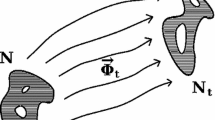Abstract
With reference to recently proposed theoretical models accounting for reduction in terms of a unified dynamics governing all physical processes, we analyze the problem of working out a worldview accommodating our knowledge about natural phenomena. We stress the relevant conceptual differences between the considered models and standard quantum mechanics. In spite of the fact that both theories describe systems within a genuine Hilbert space framework, the peculiar features of the spontaneous reduction models limit drastically the states which are dynamically stable. This fact by itself allows one to work out an interpretation of the formalism which makes it possible to give a satisfactory description of the world in terms of the values taken by an appropriately defined mass density function in ordinary configuration space. A topology based on this function and which is radically different from the one characterizing the Hilbert space is introduced, and in terms of it the idea of similarity of macroscopic situations is precisely defined. Finally, the formalism and the interpretation are shown to yield a natural criterion for establishing the psychophysical parallelism. The conclusion is that, within the considered theories and at the nonrelativistic level, one can satisfy all sensible requirements for a completely satisfactory macro-objective description of reality.
Similar content being viewed by others
References
A. Shimony, inPhilosophical Consequences of Quantum Theory: Reflections on Bell's Theorem, J. T. Cushing and E. McMullin, eds. (University of Notre Dame Press, Notre Dame, Indiana, 1989).
J. S. Bell, inQuantum Gravity 2, C. Isham, R. Penrose, and D. Sciama eds. (Claredon Press, Oxford, 1981).
G. C. Ghirardi, A. Rimini, and T. Weber,Phys. Rev. D 34, 470 (1986).
P. Pearle,Phys. Rev. A 39, 2277 (1989); G. C. Ghirardi, P. Pearle, and A. Rimini,Phys. Rev. A 42, 78 (1990); G. C. Ghirardi and A. Rimini, inSixty-Two Years of Uncertainty, A. Miller ed. (Plenum, New York, 1990).
A. Shimony, inPSA 1990, Vol. 2, A. Fine, M. Forbes, and L. Wessels, eds. (Philosphy of Science Association, East Lansing, Michigan, 1991).
D. Z. Albert and B. Loewer, inPSA 1990, Vol. 1, A. Fine, M. Forbes, and L. Wessels eds. (Philosophy of Science Association, East Lansing, Michigan. 1990).
G. C. Ghirardi, R. Grassi, and P. Pearle,Found. Plus. 20, 1271 (1990); inSymposium on the Foundations of Modern Physics 1990. P. Lahti and P. Mittelstaedt eds. (World Scientific, Singapore, 1991); G. C. Ghirardi, and P. Pearle inPSA 1990, Vol. 2. A. Fine, M. Forbes, and L. Wessels eds. (Philosophy of Science Association, East Lansing, Michigan, 1991).
G. C. Ghirardi, R. Grassi, J. Butterfield, and G. N. Fleming.Found. Phys. 23, 341 (1993);J. Butterfield, G. N. Fleming, G. C. Ghirardi, and R. Grassi,Int. J. Theor. Phys. 32, 2287 (1993).
J. S. Bell, inSchrödinger-Centenary Celebration of a Polymath, C. W. Kilmister ed. (Cambridge University Press, Cambridge, 1987).
F. Karolyhazy,Nuovo Cimento A 42, 390 (1966) and references therein; A. B. Komar,Int. J. Theor. Phys. 2, 157, (1969); R. Penrose, inQuantum Concepts in Space and Time, R. Penrose and C. J. Isham, eds. (Clarendon, Oxford, 1986); J. Ellis, S. Mohanty, and D. V. Nanopoulos,Phys. Lett. B 221, 113 (1989); L. Diosi,Phys. Rev. A 40, 1165 (1989); A. Frenkel,Found. Phys. 20, 159 (1990).
G. C. Ghirardi, R. Grassi, and A. Rimini,Phys. Rev. A 42, 1057 (1990).
P. Pearle and E. Squires, to be published inPhys. Rev. Lett.
F. Benatti, G. C. Ghirardi, and R. Grassi, inProceedings of the International Course on Advances in Quantum Phenomena, E. Beltrametti and J. M. Levy-Leblond eds. (Plenum, New York, to appear).
A. Rimini, inProceedings of the International Course on Advances in Quantum Phenomena, E. Beltrametti and J. M. Levy-Leblond, eds. (Plenum, New York, to appear).
F. Benatti, G. C. Ghirardi, A. Rimini, and T. Weber.Nuovo Cimento B 100, 27 (1987).
J. S. Bell, inProceedings of the Nobel Symposium 65: Possible Worlds in Arts and Sciences (Stockholm, 1986).
A. J. Legett,SSuppl. Prog. Theor. Phys. 69, 80 (1980).
J. S. Bell, CERN-TH. 4035/84, 1984.
D. Z. Albert and L. Vaidman,Phys. Lett. A 139, 1 (1989); D. Z. Albert inSixty-Two Years of Uncertainty, A. Miller ed. (Plenum, New York, 1990); D. Z. Albert,Quantum Mechanics and Experience (Harvard University Press, Cambridge, Massachusetts, 1992).
F. Aicardi, A. Borsellino, G. C. Ghirardi, and R. Grassi,Found. Phys. Lett. 4, 109 (1991).
J. S. Bell, inSixty-Two Years of Uncertainty, A. Miller, ed. (Plenum, New York, 1990).
Author information
Authors and Affiliations
Rights and permissions
About this article
Cite this article
Ghirardi, G.C., Grassi, R. & Benatti, F. Describing the macroscopic world: Closing the circle within the dynamical reduction program. Found Phys 25, 5–38 (1995). https://doi.org/10.1007/BF02054655
Received:
Issue Date:
DOI: https://doi.org/10.1007/BF02054655




